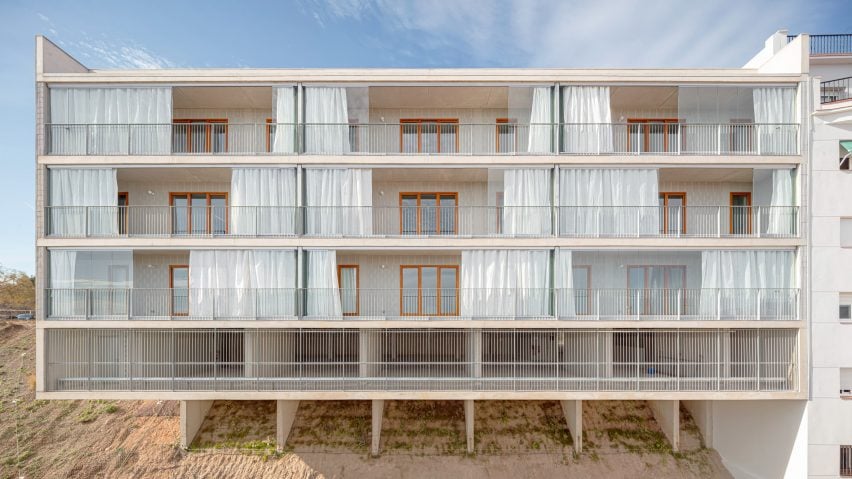Spanish architecture studios DataAE and Xavier Vendrell have balanced two rows of social housing on a hillside in Barcelona overlooking the Mediterranean Sea.
The project includes 39 units – a total of 4,785 square metres (51,500 square feet) – broken into three volumes that are oriented towards the water.
Claudi Aguiló and Albert Domingo, who run DataAE, and Xavier Vendrell Studio respectively, worked to create the project on a steep site at the edge of town.
The three volumes "break the linearity of the street facade and create a transition to the nearby park," Xavier Vendrell told Dezeen.
Taking advantage of the suburban condition and the 18-metre elevation difference between neighbouring streets, one volume is located at the top of the slope with a 4.2-metre overhang that minimises the foundation in the rocky terrain.
Separated by shared green space, the second building contains ground-floor parking and direct access to Parc De Les Bateries, continuing the existing urban fabric while generating a new facade that respects the natural environment.
The buildings are constructed with bi-directional, reinforced concrete slabs, and the exterior walls are composed of 30-centimetre Termoarcilla, lightened fired clay bricks with fire resistant, noise reduction and thermal insulation properties.
The Termoarcilla was topped with white stucco for a uniform, neutral exterior finish.
The entire complex was arranged to prioritise views of the sea – from the housing units to both lobbies, to the vertical circulation cores. Additionally, the layout gives each unit ample natural light and a corresponding outdoor space.
The upper volume includes 17 apartments arranged around a central passageway and staircase with five two-bedroom units and one single-bedroom unit per floor. Balconies run along the eastern side of the building.
The lower building is broken into two forms by a vertical circulation core that branches out to five three-bedroom units and one two-bedroom unit on each floor, totalling 22 apartments in the building.
"On the southeast facades there are bioclimatic galleries that improve habitability and energy efficiency, while on the northwest facades there are filter spaces, open to the outdoors but for private use," Vendrell said.
"These improve the management of privacy between the collective walkway and the glazed facade of access to the dwelling."
"The result is a single type of housing that adapts to the different conditions of aggregation and geometry without losing its operational logic, an abstract space of living and dining, rectangular and passing, always with cross ventilation," the team explained, noting the access on one side of each apartment and a large opening on the other.
On the interiors, the neutral tones continue with white painted brick and drywall, and exposed concrete slab in the public corridors. Laminated parquet flooring and natural wood doors and window frames add warmth to the spaces.
The project has an "A" energy certification with nearly zero energy demand and a low-transmittance thermal envelope.
"To avoid overheating in the summer, the building is provided with solar protection and good ventilation combined with the inertia of the interior floors to optimise night ventilation."
The project includes units for sale – listed at a rate of 2,400 euros per square metre – and for rent. Residents must meet income requirements that are regulated by the government.
Previously, DataAE and H Arquitectes designed student housing in St. Cugat using a similar ventilated corridor strategy. Meanwhile, Xavier Vendrell and Mary English constructed an infill house in San Antonio, Texas ventilated with three interior courtyards.
The photography is by Adrià Goula.
Project credits:
Architects: dataAE (Claudi Aguiló, Albert Domingo) + Xavier Vendrell Studio
Team members: Pau Cornellana, Ileana Manea, Andrea Rodríguez
Environmental consultant: Societat Orgànica +10
Structural engineering: Manuel Arguijo y Asociados
Building physics: Eletresjota tècnics associats
Quantity surveyor: Eulàlia Aran Corbella
Client: IMPSOL

